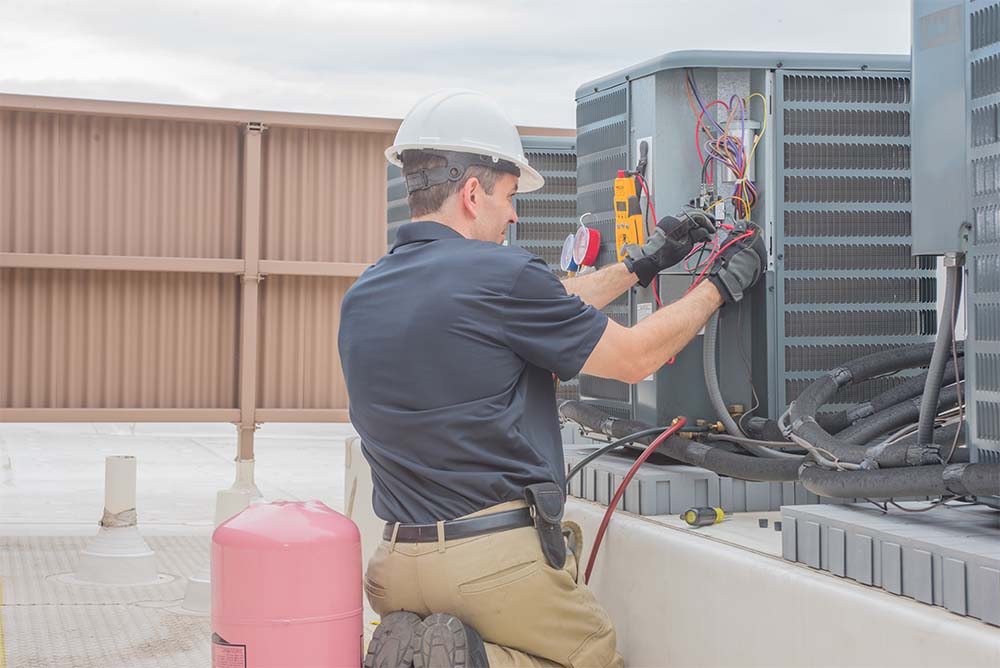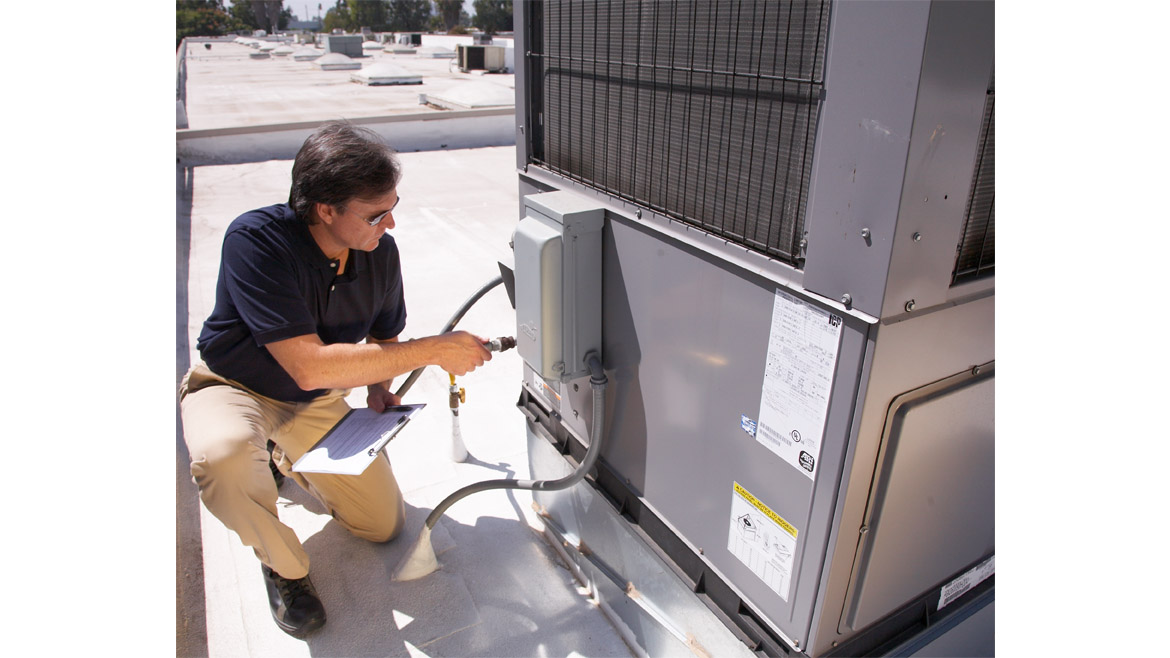The HVAC industry is in the midst of another refrigerant transition, as the federal AIM Act mandated an 85% phasedown of HFC refrigerants by 2036. Unlike the previous transition from R-22 to R-410A, which were both nonflammable (A1) refrigerants, this one involves alternatives that are lower flammability (A2L), but many state building codes do not yet allow their use in stationary comfort cooling equipment.
Several states have already updated their building codes to allow the use of A2L refrigerants in larger air conditioners and heat pumps, but others are waiting for the international code bodies to release their 2024 mechanical codes. In the U.S., states usually adopt mechanical codes from either the International Code Council (ICC) or the International Association of Plumbing and Mechanical Officials (IAPMO). Both will soon complete their 2024 mechanical codes, which may include the use of A2L refrigerants, and contractors should become familiar with those possible provisions.
Director of PMG technical resources, ICC
ICC International Mechanical Code
The Code Council is a non-profit organization that helps bring all stakeholders together to create modern, cost-effective building codes. The International Mechanical Code (IMC) and all International Codes (I-Codes) are updated every three years, and changes are made through a transparent and inclusive consensus-based process, said Jim Cika, director of PMG technical resources for the Code Council. Once these revised codes are published, they will not be in effect until they are adopted by a state or local jurisdiction.
The 2024 IMC codes, along with the other 2024 I-Codes addressing A2L refrigerants, are expected to be published mid-to late 2023. While adoption of the 2024 model codes is not possible until the codes are published, said Cika, the new code provisions that have been approved for the 2024 IMC and the other I-Codes are available online and can be incorporated as amendments to currently adopted codes.
“For example, jurisdictions that have adopted the 2021 I-Codes can incorporate the new 2024 provisions into their 2021 codes through the amendment process,” he said. “We are encouraging states and local jurisdictions to prepare to adopt the 2024 codes early and/or incorporate the new 2024 provisions as soon as possible.”
Right now, the majority of U.S. jurisdictions have adopted the 2012, 2015, 2018, or 2021 codes, said Cika, and the Code Council is currently working with state and local jurisdictions to get them ready for 2024, including seeing what would be required for them to amend their existing codes to be in compliance with the new 2024 code.
“For this transition to go smoothly and to meet the federal mandate, it's going to be absolutely necessary for them to have measures in place to allow the use of A2L refrigerants, beginning in 2024,” he said.
To that end, the 2024 IMC approves the use of A2L refrigerants for comfort cooling, noted Cika, and while the code language is consistent with ASHRAE Standard 15-2019 and UL 60335-2-40, it is not identical. “As an example, there are sections of ASHRAE 15 that list refrigerants that are prohibited for use in comfort cooling, where the IMC will list refrigerants that can be used in this application. In other instances, the code references the ASHRAE or UL standards directly, requiring compliance with the standards so that there is no ambiguity between the documents.”
There are also limitations to the use of A2Ls in the 2024 IMC, including a limit to the amount of A2L refrigerant that can be used within an air conditioning system used for comfort cooling. Residential systems will have a limited maximum capacity of 6.6 pounds of refrigerant, and commercial systems will have a limit of up to 22 pounds of refrigerant.
“Contractors should also be aware that there will be a requirement for ‘Risk of Fire’ labels for A2L piping due to its flammability,” said Cika. “In addition, the machinery rooms for Group A2L and B2L refrigerant must comply with elevated temperature, refrigerant detector, and mechanical ventilation requirements consistent with ASHRAE 15. In terms of complying with elevated temperatures, this means that rooms housing the A2L refrigerants cannot contain flame-producing equipment or equipment with continuously hot surfaces above 1,290°F.”
Another change in the IMC 2024 is that equipment using Group A2L, A2, A3, or B1 refrigerant must comply with UL 484, UL/CSA 60335-2-40, or UL/CSA 60335-2-89. By adding this requirement, said Cika, the code clarifies what safety standards should be used for equipment utilizing these refrigerants. In addition, the new ASTM A333-18 Standard, Standard Specification for Seamless and Welded Steel Pipe for Low-Temperature Service and other Applications with required Notch Toughness, has been added to Table 1107.4, Refrigerant Pipe, so that Table 1107.4 is now consistent with ASHRAE 15.
“Contractors and distributors need to be preparing for this transition now, as they will need to confirm that the tools and instruments they use today are compatible with A2L refrigerants, including their vacuum pumps, leak detectors, and refrigerant recovery equipment,” said Cika. “Supply chain issues might make getting new equipment a challenge, so they need to review and understand the new requirements and procedures related to storing, handling, and using A2Ls.”

COMPATIBLE TOOLS: Contractors should be preparing for the transition now, as they will need to confirm they have tools that are compatible with A2L refrigerants. (Courtesy of Code Council)
IAPMO Uniform Mechanical Code
IAPMO’s Uniform Mechanical Code (UMC), which is used by states including California, Nevada, New Mexico, and Texas, is also updated every three years. The development process includes a proposal and comments stage, during which time anyone from the public may submit changes to the published edition of the code and/or submit comments to any changes being proposed to the published edition, said Hugo Aguilar, senior vice president of codes and standards at IAPMO.
“Every proposal and comment received is considered by a balanced technical committee, in which no single interest category exceeds one-third of the overall committee,” he said. “The first step is the proposal stage, the second step is the comments stage, and the final step is the appeals and publication of the code. All proposals and comments submitted for the UMC are reviewed and acted upon by the balanced committee in accordance with the ANSI-accredited codes development process and the ANSI Essential Requirements.”
The 2024 UMC is in the final stages of the development cycle and is scheduled to be available in 2023. Those who follow the process will see working drafts of the UMC in a preprint version. However, the final content of the UMC will be available when the Standards Council issues the newest edition at the conclusion of the process. This ensures input at various steps in the process, including appeals before the code is considered final.
As published in the Report on Comments for the development of the 2024 UMC, the Technical Committee recently moved forward comments to include language for A2L refrigerants for comfort cooling, and the language correlates with ASHRAE Standard 15-2019. The Technical Committee determined that correlating with other existing ANSI documents is crucial for consistency and harmonization and to avoid confusion in the industry, noted Aguilar. References to UL 60335-2-40 for refrigeration appliances are included in the 2021 edition of the UMC.
The 2018 UMC included A2L requirements in a model code for machinery rooms, noted Aguilar.
“The human comfort requirements were approved by the Technical Committee in a recent letter ballot and available for review in the Report on Comments. At the September 2022 IAPMO Association Technical Meeting Convention, the membership had the opportunity to speak on this important change before it moved to the final stages of the process.”
The Technical Committee also moved forward comprehensive provisions for other mechanical systems, but as with human comfort requirements for A2L refrigerants, these provisions are not final, said Aguilar.
As for a timeline to when jurisdictions may adopt the 2024 UMC once it becomes available, it varies, as each state has its own adoption process. In California, for example, once a new edition is published, it is typically adopted two years later, as it must go through a thorough review and amendment process, said Aguilar.
The 2024 mechanical codes will likely contain significant changes regarding A2L refrigerants used for comfort cooling, and contractors should become familiar with them. Equipment containing these mildly flammable refrigerants is already available in some states, and more states are amending their building codes to allow their use. So it’s time to get ready, as A2Ls are coming, and contractors should be in front of this transition.



Report Abusive Comment